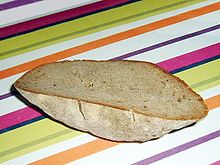edge
The edge (from "edge"; term used especially in northern Germany ) is the cut or the end piece of a loaf of bread . In the bakery industry , edges are called trimmings and cuts .
Other regional names
Different designations for the approach and section are also used in different regions. The fact that there is an expression for this part of the bread at all is due to the fact that the cutting of freshly baked bread was very popular, while the end piece, which only had to be consumed after several days, was already hard and dry and often had to be immersed in liquid before one could consume it.
- By Knust, Knus, Kniest, Knistchen, Kniezchen, Knüppchen, Küppchen or Knaust spoken in the northeast and the northwest of Germany, but also partly in East Middle .
- Knorz, Knörzel, Knüstchen, Kürschtje, Knapp or Knäppchen, Knörzchen, Knärzchen, Knetzle, Knerzla or Köppla are used in the Rhineland , Hesse , Franconia and neighboring areas.
- Rand, Ränftchen, Ranft, Ranften, Ranftl, Ränftl, Ränftel, Rauft, Rindl, Rumptschn are expressions for edges in central and southern Germany .
- In Central Thuringia the terms Feeze or Fietze are also known , in South Thuringia the Küppel .
- Knäusle, Knüssle, Mürggel, Riebel, Riebele (also Brottriebel) are expressions that are used in the Swabian-Alemannic language area.
- A variant that is particularly widespread in Bavarian and Austrian is the Scherzl or Scherze (r) l (from Italian scorza "bark") and only affects the end pieces.
- In the Palatinate , the term Knorze is common.
- Krüstchen is what they say in the Limburg region, in the hinterland and in the Westerwald.
- In Swabia you can occasionally hear the term giggel for all types of bleed .
- In the Viennese dialect , Bugl (for Bugel or Buckel ) is used. This is particularly in connection with the order at the sausage stand (“A Eitrige, an Bugl and a 16er Blech” for “A cheese krainer, a bread end piece and a can of Ottakringer beer ”).
Knust and Knaust also stand for a thick, misshapen, not neatly cut piece of bread or part of a roll. There are also several colloquial variants for this. This is how they say Trumm in Austria , Mocken in Upper Germany and Runken or Ranken in North and Central Germany . There is the Ranften in Upper Franconia. The term Knust is also used regionally for the core of pome fruit .
As diminutive forms for the edges exist z. B. Käntchen and jug. Jokingly the edges will swing Bemme or " butt called". In the Nieukerker and Geldern rooms, the term "Popöchen" is also used humorously for the end of a loaf of bread.
See also
literature
- Wilfried Seibicke: Duden: How do you say elsewhere? Landscape differences in German usage. 2nd Edition. Bibliographical Institute, Mannheim / Vienna / Zurich 1983, ISBN 3-411-01978-6
- Eberhard Krienke: Us Uckermark. Language and vernacular literature of a region. Schibri Verlag, Mirow 1996, ISBN 3-928878-46-8
Web links
Individual evidence
- ↑ Edges on Duden.de
- ↑ a b From Knäppchen, Knäuschen and Knörzchen. In: Spiegel Online , September 13, 2006; Retrieved August 19, 2012.
- ↑ Jokes to jokes. In: Jacob Grimm , Wilhelm Grimm (Hrsg.): German dictionary . tape 14 : R - skewness - (VIII). S. Hirzel, Leipzig 1893, Sp. 2597-2600 ( woerterbuchnetz.de ).
- ↑ Slice of bread - hump. Entry in ostarrichi.org - Language in Austria. Retrieved August 19, 2012.
- ↑ Robert Sedlaczek : The 16 mm sheet makes a career. Sedlaczek on Wednesday . In: Wiener Zeitung , March 13, 2007. Retrieved on August 19, 2012.
